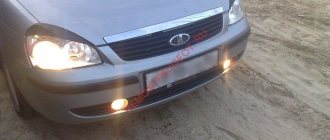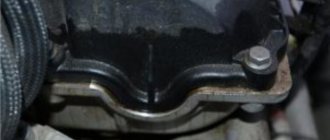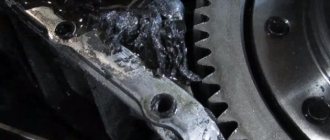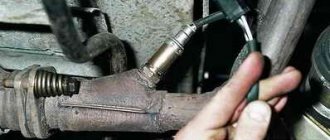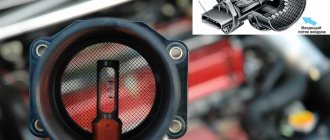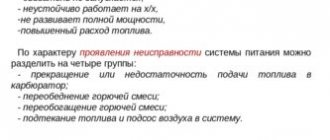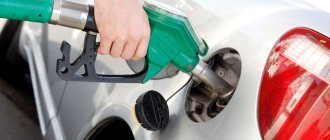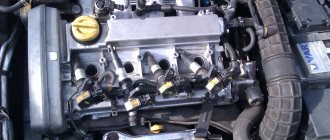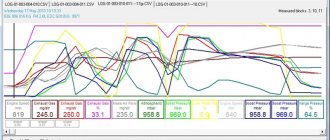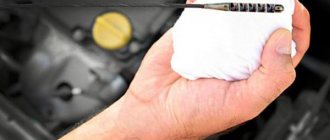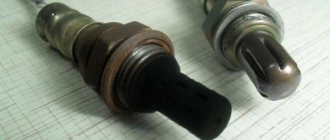A car with a faulty fuel injection pump loses power, increases fuel consumption, has problems starting the engine, increases smoke from the exhaust system, etc. There can be many reasons leading to pump malfunctions, from the appearance of moisture in the plunger pair to problems in the electronics. The best way to check the fuel injection pump is at a stand at a service station, but some faults can be determined independently in your garage. To learn how to do this, you should be able to identify the signs, and for this you need to know the reasons leading to this.
Symptoms of a problem
Let us highlight the main signs by which to judge a fuel injection pump malfunction:
- Fuel consumption has increased.
- The motor operates intermittently in any mode.
- Difficulty starting the engine, especially in winter.
- A noticeable drop in engine power.
- The exhaust turned black or gray.
- The engine noise has increased.
- The engine stalls at idle when warm, but starts easily when cold.
What car enthusiasts say about fuel injection pump repair
- Price and repair time “My car uses a spray injection pump. Diagnostics showed that the nozzles are working properly, but the plunger is worn out. Ordered for 9 thousand rubles. original plungers. Now we have to wait a whole week for them to come and repair the injection pump. And the vacation is passing..."
- Is dealer repair always good?
“In the 90s, I was an employee of a company that had a ZIL-4331. A good idea, poorly implemented in metal - that’s what you can say about this car.The car was driven straight from the factory, the mileage was low. The driver complained about smoke, but the problem was resolved by replacing the nozzles. We sent the car for repairs to Moscow to the ZIL plant!!!
After the repair, the car refused to start at all. An examination at the stand showed that seven out of eight injectors are leaking...
Such a factory repair...
Uncle Vasya eliminated malfunctions and repair sins on the basis of the factory fleet.”
Causes of malfunctions
Fuel injection pump malfunctions can be caused by the following reasons.
- Plunger pairs. Contamination or wear of these pairs is the most common cause of malfunctions. The reason is simple - low-quality fuel and dirt. Wear occurs due to debris or water entering these vapors; worn parts no longer cope with the task.
- Water ingress. Low-quality fuel often contains water, which will sooner or later get into the pump. This increases wear on parts and causes corrosion. Interruptions in operation are also caused by water, which is supplied instead of fuel or with fuel in half.
- Clogged fuel filter. Leads to contamination and wear of plunger pairs, reduces fuel supply, which causes interruptions in engine operation. Pump parts for which fuel is a lubricant are destroyed by its lack.
- Impaired fuel distribution. Different amounts of it are supplied to the cylinders, causing an imbalance in the operation of the engine and smoking. The reason is clogged injectors or worn-out pairs.
- Defective parts. It is a rare case that the fuel injection pump housing cracks, the bearings are destroyed or the plungers jam. This is the problem with cheap pumps. Severe wear of parts is also caused by violation of operating conditions and aging, since nothing lasts forever.
- Cooling failure. Due to poor cooling, the pump overheats, which quickly damages the parts and can cause them to jam. It is cooled by diesel fuel, which it pumps, so the fuel filter may be clogged or the drive belt may be overtightened.
- Depressurization. Depressurization of the pump will reveal itself as trickles and drips of fuel, which will inevitably occur. Look for broken gaskets, cracks and other damage.
- Injection failure. Failure to adjust or operate the injection control valve. The engine runs intermittently and smokes. You need to check the valve (if there is one), adjust the injection and at the same time check the injectors, they can also be the cause of such a failure.
- The plunger spring is broken. The return springs of the plungers break, but the plunger does not completely return to its place (its stroke is reduced), as a result of which the fuel supply occurs in a reduced volume. There is a tripping of the engine, wandering speeds, and vibrations.
- The pump rack is faulty. Violation of the mobility of this rack interferes with the fuel supply to the engine. If it is stuck in the engine off position, the engine will not start. If the jam occurs at maximum speed, the engine goes into overdrive, forced to work at the limit of its capabilities.
- Freezing. In cold weather, pump parts freeze and paraffin precipitates in diesel fuel, clogging fuel filters and lines. To avoid such troubles, it is recommended to use winter or arctic diesel fuel (depending on frost) and use additives for freezing and defrosting before frost sets in.
Removing the injection pump from the engine
Removing the fuel injection pump may be necessary not only to find and repair faulty parts, but also to check the injectors and adjust the gas distribution mechanism. Removing the fuel injection pump is a rather labor-intensive task that not every car owner can handle. At a minimum, to carry out such an operation you must have considerable experience in independently repairing a car.
Removal of the injection pump is carried out in several stages. Depending on the type of pump, there may be differences in the sequence and some details of the process. To remove the injection pump, in addition to standard keys, you will need special devices - gears for cranking the crankshaft, clamps, stocks, drive gear pullers, spline keys and special tools for dismantling. Therefore, when removing the pump, it is advisable to use a set of tools for repairing the injection pump.
- First, you should drain all the coolant in the car.
- Next, the negative terminal of the battery is disconnected.
- The fan and fan casing are removed, complicating access to the injection pump housing.
- Then the cylinder head cover is removed.
- Next, remove the timing belt cover.
- Then the intake manifold is dismantled.
- Next, the first cylinder of the engine must be set to the top dead center position (the maximum distance between the cylinder and the crankshaft). To lock the cylinder in this position, use special tool 11 2 300.
- Then it is necessary to remove the timing belt from the camshaft pulleys and the injection pump shaft.
- Next, you need to disconnect the fuel line and drain wire from the pump. The oil drain hose is also disconnected.
- Next, you need to disconnect the distribution lines from the cylinder injectors using tool 13 5 020.
- Next, the electrical wiring parts are disconnected.
- Then you need to remove the fuel injection pump fasteners. To remove the central nut of the injection pump, first remove the cap nut, and then unscrew the central nut with an 18-mm open-end wrench.
- Next, the bolts on the fuel injection pump housing are turned out.
- To disconnect the injection pump from the sprocket, use the ejector screw and fixture 13 5 120, which is first screwed into place of the central nut. When removing the injection pump, the device must remain on the central pulley until the pump is installed back to avoid the sprocket falling.
Once the injection pump is separated from the center pulley and sprocket, it can be carefully removed. Further disassembly to search for faulty parts can also be carried out using a specialized kit for repairing high-pressure fuel pumps.
Checking the injection pump
Let's move on to checking the injection pump, the methods are as follows.
- At the stand. The best way to check and adjust any injection pump is a stand at a service station. Such a check reveals all malfunctions and irregularities in operation. However, the service is paid and you cannot do it on your own. Therefore, let’s move on to what you can check with your own hands.
- Availability of water. To determine whether water has entered the pump, remove the drive belt from it. After this, rotate the pulley manually. Rotation should occur either easily or with difficulty, this means that no water gets inside. If it does not rotate or requires a lot of effort, then there is water inside the pump and you need to get rid of it.
- Pressure check. To check the pressure of the plungers, you need a special tester or pressure gauge with a large measuring range. A pressure of about 300 kg/cm means the plungers are working properly. It is better to check the manual for your specific pump. Lower readings indicate that the pair is worn out and requires replacement.
- Control sensors. It is checked for errors using a scanner; if there is no scanner, contact a service station where such equipment is available.
- Fuel leak. It reveals itself as drips and streams of diesel fuel when the engine is running. Look for leaks and eliminate the cause.
- Rail jamming. To check, you should disconnect its rods from the regulator and bracket. Then move it to the extreme position using the control levers on the pump. When moving, it becomes clear whether there are jams or not.
- Pump freezing. You can only check the heating pump. Heating with an open fire is dangerous to life, so it should be warmed up by rolling the car into a warm garage, or by turning on the heating of the garage if the car is already in it. Use an engine defroster. Removing, disassembling and washing the pump takes a long time and requires professional knowledge, otherwise don’t even try to do it.
Diagnostics of fuel systems of diesel engines
As you can see, although timing valves, pistons or rings may well fail in a diesel engine, most diesel malfunctions are related to the power system.
For this reason, checking the components and elements of the fuel system is a primary task.
Owners of diesel internal combustion engines regularly encounter coking of the nozzle on the injectors or deterioration of needle mobility. Also, the check often reveals a decrease in injection pressure, which is usually associated with wear or damage to the plunger pairs.
The discharge valves may also be worn out, and another common situation is a violation of the correct adjustment of the fuel injection pump. As a rule, such problems are caused by severe operating conditions, violation or ignorance of basic engine maintenance recommendations, as well as the use of low-quality diesel fuel.
Among the main diagnostic methods, experts identify three:
- Visual inspection and analysis of noise during engine operation.
- Measurements of certain parameters (fuel pressure, etc.).
- Computer diagnostics of a diesel engine.
In the first case, you can quickly identify serious faults that lead to obvious malfunctions in the operation of the power plant. If the technician is experienced, then one visual inspection will be enough to assess the condition of the engine, critical components of the fuel supply equipment, etc.
The air filter, the sound of the diesel engine and fuel injection pump at idle and under load, the color of the exhaust gases, the appearance of the glow plugs and inspection of other elements allow you to draw conclusions about the condition of the internal combustion engine.
- In the second case, it is assumed that the technician has localized the problem, but a more accurate determination of the problem is necessary using measurements of a number of parameters that will indicate deviations in the operation of a particular system or the motor itself.
We also recommend reading the article about
why does a diesel engine troit
. From this article you will learn about the possible reasons for the unstable operation of a diesel engine and cylinder tripping.
Such diagnostics of the fuel system of diesel engines and other components is usually carried out on machines where electronic diagnostics using scanners is impossible (old diesel with a mechanical injection pump). In this case, you will need to remove the injectors to check them, measure compression, boost pressure, crankcase gas pressure, check filters, valve timing, install drive belts, diagnose glow plugs, etc.
For example, compression measurements in cylinders are often carried out if a diesel engine is running rough. Troubling may indicate both problems in the power system and malfunctions in the power unit. In a situation where compression is low, the fuel does not burn and the cylinder simply does not work. This means that it is not the fuel supply elements that need to be repaired, but the engine itself.
- The third method allows you to identify failures and breakdowns both in the electronic engine control system (ECM) and a number of “mechanical” problems. Computer diagnostics allows you to check the operation of sensors and control electronics, as well as, based on the analysis of readings from sensors, determine other malfunctions.
Nowadays, computer diagnostics of a diesel internal combustion engine allows for a multi-level check of the unit, diagnosing the fuel system, control system, and actuators.
As for the diagnostics of fuel equipment of diesel engines, at the initial stage the operation of the “electrical” part of the injectors is analyzed, computer scanning also determines temperature indicators, parameters are measured during operation of vacuum devices, etc.
Next, all collected readings are evaluated, after which the computer displays error data, which allows you to begin eliminating the detected defects. The main advantage of such diagnostics is the simplicity, speed of operation, and the absence of the need to disassemble the engine and carry out additional manipulations.
Repair
Do-it-yourself repair of a high-pressure fuel pump requires knowledge of the structure and method of disassembling/assembling your particular unit. The procedure may be slightly different for each fuel injection pump model, but something like this:
- disconnect the battery;
- disconnect all tubes and the drive belt from the fuel injection pump;
- if necessary, remove all parts that interfere with the removal of the injection pump;
- unscrew the fastenings and remove the pump;
- disassembling the pump is carried out carefully, remembering the sequence and without losing small parts;
- clean all parts to identify damaged ones;
- plunger pairs are replaced only as a pair (it is impossible to change one plunger or one sleeve);
- assembly is performed in the reverse order, after replacing all damaged parts;
Checking the diesel fuel injection pump at home
A car with a faulty fuel injection pump loses power, increases fuel consumption, has problems starting the engine, increases smoke from the exhaust system, etc.
There can be many reasons leading to pump malfunctions, from the appearance of moisture in the plunger pair to problems in the electronics. The best way to check the fuel injection pump is at a stand at a service station, but some faults can be determined independently in your garage.
To learn how to do this, you should be able to identify the signs, and for this you need to know the reasons leading to this.
Types of fuel pumps
First, you should understand the types of fuel injection pumps for diesel cars, since each of them has its own typical features and breakdowns. However, all pumps, regardless of variety, have one main unit, namely plunger pairs (pistons and cylinders).
Injection pumps are divided into types according to the principle of injection:
- direct action with a mechanical plunger drive;
- battery injection.
In addition, high-pressure pumps are also divided into classes according to their design:
- In-line - the working segments are installed in a row, diesel fuel is injected in turn into all cylinders.
- Distribution - fuel from one section is supplied to several cylinders. They come in both single-plunger and double-plunger types.
- Multi-section - better known as a V-shaped or hydraulic accumulator. Installed on engines with high power but low speed.
On a direct injection injection pump, injection and delivery occur simultaneously through a mechanical plunger drive. On battery types, fuel is supplied in separate cycles - first it is pumped into the pump accumulator, and then into the injectors. With modern models, the entire process is controlled electronically.
https://www.youtube.com/watch?v=aUEkQM0MbNou0026t=152s
Injection pumps are also installed on gasoline vehicles. Used on engines with direct injection. The pump is necessary to supply fuel to the cylinder chamber under high pressure, and a combustible mixture is formed in it, which is ignited by the spark plug.
Signs of a high pressure pump malfunction
Most of the symptoms of fuel pump malfunctions are the same or very similar for most types and types. These include the following symptoms:
- a sharp increase in fuel consumption;
- engine operation becomes unstable, especially at low speeds;
- problems when starting the engine, extremely sensitive during cold periods of the year;
- reduction in car power;
- increased smoke from the exhaust pipe;
- leakage of diesel fuel from the injection pump;
- increase in noise when the engine is running.
Car owners with extensive experience note another clear sign of problems with the pump plunger - at idle, a “hot” engine can stall for no apparent reason. It cannot be started until the pump has cooled to normal temperature. A “cold” engine starts normally.
Causes of fuel injection pump breakdowns
There are several most important reasons why a high pressure pump fails. This is usually due to the breakdown of the following parts:
- Plunger. The most common cause is contamination of the plunger pair. There are two main factors here. The first is the nature of the design (for example, the gap is too small). The second is poor fuel quality (presence of undesirable impurities clogging the device). In addition, contamination can also come from the engine - soot, dirt, etc. The operation is also affected by the wear of the plunger pair, which leads to severe overheating of the bearings.
- Presence of water in fuel. Moisture can wash away the fuel layer that protects the surfaces of precision parts of the high-pressure pump, which leads to a decrease in its service life and even possible jamming.
- Fuel filter is dirty. This leads to possible dirt getting into the plunger pair, and the pump also wears out.
- Irregularities in fuel supply and distribution. Another common reason for this is a malfunction of the plunger pair, namely wear of the drivers, teeth on the rack, discharge valves and contamination of the nozzles.
- Defective parts. Quite rare, but still found on cheap pumps. This may include cracks and chips of the housing, damaged bearings, jamming of plunger bushings, and the like.
- Bearing wear. More often caused by aging or defective parts. This leads to malfunctions of the pump, and the bearing itself and nearby parts overheat, which reduces its service life.
- Jamming of pistons and bushings. Leads to failure of the rack, cam shaft, gear, governor and keys. More often caused by moisture entering the cavity between the piston and bushing.
- Wear of injection pump components. Occurs as a result of aging or after water penetrates inside, which leads to corrosion of pump parts.
- Corrosion of the plunger pair. Appears when there is a large amount of water in the fuel.
- Problems in the cooling system. In other words, with prolonged use or heavy loads, the pump simply overheats. Cooling malfunction can be caused by insufficient antifreeze, blockages, breakdown of individual parts, etc.
If you suspect a faulty operation of the injection pump rack or related elements, you must check the following components for serviceability:
- detaching the rack from the regulator parts;
- check the clamps of the plunger leads;
- jamming of the gear rim screws.
The most dangerous cause of failure is a malfunction in the mobility of the fuel supply rack.
If it is wedged at maximum fuel supply so that the regulator cannot return it to the reverse position, then the crankshaft speed in the engine sharply increases.
This leads to the engine starting to work at the limit, and this is fraught with consequences. If the rack wedge is in the off position, the engine will not start.
When operating a car in low temperature conditions, there are cases of freezing of fuel injection pump parts and components. To prevent such situations, you should use fuel and oil that correspond to the temperature conditions.
In battery injection systems (or Common Rail), there are cases of control valve failure. Most often it is immediately replaced with a new one. Sometimes it is rebuilt and some parts are replaced.
Determining faults in fuel injection pump
It is worth remembering that the most reliable data on the condition of the fuel pump can only be obtained after checking it at a special stand in a car repair shop. Naturally, such diagnostics at home is impossible without special equipment. But it is still possible to check some elements and the correctness of their operation.
Water in plungers
To do this, you will need to remove the belt from the timing mechanism and carefully rotate the pulley. When rotating with variable forces, there is no water. If you have to apply significant force when rotating or you can’t turn it at all, then there is moisture.
The presence of moisture in the fuel injection pump is extremely harmful both for it and for the entire engine. This leads to rapid wear of parts and a reduction in their service life, and can also cause corrosion and even a complete wedge of the unit.
Pressure in the plunger pair
You can check it using a special tester - KI-4802 or TAD-01A. If there is none, then a regular pressure gauge with a large measurement range will do.
The device is screwed in instead of the fuel pipe or fixed in the central hole of the injection pump head. The engine is then started and readings are taken. Under normal conditions the value should be close to 300 kg/cm2.
This is a conditional value and depends on many factors, the main thing is that during testing the figure is as close as possible to the specified one.
If the system pressure is significantly lower than 300 kg, the parts of the plunger pair are severely worn out and repair or replacement is necessary.
Checking control sensors
On diesel cars with a Common Rail injection system, the injection pump is controlled using an electronic control unit (ECU). The most common failures in them are failure of sensors or wiring.
More often this is indicated by a special signal on the dashboard - Check Engine. In this case, the error scanner needs to read the code and decipher it. Then, based on the data obtained, decide on the repair.
More often, the sensor simply expired or its wires were accidentally damaged. This leads to the fact that an incorrect signal arrives at the ECU and it begins to malfunction.
Fuel leak
If fuel is leaking from the high-pressure pump, then the cause is most often worn o-rings. To determine this, you need to shake the axis of the pump lever with the engine running. Solar oil will leak from under a damaged seal.
There are cases of fuel leakage from the installation site of the plunger pair. Then it is necessary to carry out a diagnosis. For these purposes, the pump should be removed from the car.
The tightness of the injection pump valve is checked in the following sequence:
- unscrew the high pressure tube from the defective segment;
- move the pump rack to the off-feed position;
- Use a hand pump to create pressure in the fuel system.
If the valve is faulty, fuel will appear from the pressure fitting hole. If this does not happen, the valve is working.
Grasping the rack
Before checking the rack, the rods and levers of the regulator and stop brackets should be disconnected from it. Then use the pump control levers to move the rack to its extreme position. Based on the effort when moving, we can conclude whether she is “stuck” or not. It is important to make several revolutions of the cam shaft during the process. If there are no defects, the rack will move smoothly and without shocks.
To freeze
If there are signs of fuel pump failure during the cold season, you should check it for freezing. If this happens, it must be removed from the car and brought into a warm place.
When it warms up and the mobility of the parts is restored, it must be disassembled, drained of oil and rinsed thoroughly with clean diesel fuel.
After these procedures, fresh oil is poured into the crankcase and the pump is installed back on the car.
If the pump freezes in very severe frosts, it is recommended to also use a defrost.
Prevention of fuel injection pump breakdowns
Timely implementation of the necessary preventive measures is the best repair. This will reduce financial waste due to unexpected breakdowns and extend the life of the fuel pump and the entire engine. Such measures include:
- regular flushing of the entire fuel system at least once a year;
- timely replacement of the fuel filter (cleaning is a bad option, fine dirt will still remain on the filter);
- fill the car only with high-quality fuel (gas stations have the appropriate documentation indicating the dates of delivery, composition, tolerances, seasonality and other important information; they must provide it to you upon request);
- during cold periods, use winter diesel fuel; in extreme cases, you can use a special composition to increase the fluidity of diesel fuel - anti-gel;
- if the car has to be parked for a long time, especially in winter, then it is better to fill the tank full - due to temperature changes, condensation settles on the walls of the tank, which will subsequently get into the fuel and into the injection system;
- maintaining normal fuel levels;
- in cold periods, before starting to drive, warm up the engine and all systems well, relying on the instrument readings on the panel;
- If you suspect poor quality diesel fuel, use special additives for diesel fuel.
By observing the listed preventive measures, you can extend the service life of all parts and components of the car, as well as reduce repair costs. The high-pressure fuel pump is the most important mechanism in the fuel supply system in diesel cars, so maintaining its normal operation is one of the most important points.
Conclusion
Let us remind you once again: a complete diagnosis of fuel injection pump can only be carried out in car services and service stations on a special stand. A partial check is possible on your own, but it won’t give you the full picture.
Bottom line
Self-repair of fuel injection pumps requires knowledge of the device and disassembly and assembly skills. Without this, it is better to turn to specialists for help. To prevent major problems, it is recommended to flush the fuel system at least once a year with a flush added to the fuel.
Do not forget to change filters in a timely manner, and prepare for the winter period with the help of winter diesel fuel or additives. Refuel only at proven gas stations to avoid using bad fuel.
0
Author of the publication
offline for 2 months
How to prevent malfunctions in the fuel system of a diesel engine?
There are a number of reasons why a diesel engine's fuel system may malfunction. But the most important reason is wear of certain parts . First of all, pay attention to the axis of the regulator lever - it wears out the fastest. Over time, the elasticity of the rubber sealing ring, which is at the low pressure stage, may be lost. In addition, during active use of the car, various types of extraneous accumulations occur. It is necessary to periodically get rid of carbon deposits and dirt, so all parts of the system will work more reliably and longer.
It is easy to notice any malfunction if, for example, the car does not start so smoothly or periodically while driving sharp sounds begin to be heard from the exhaust pipe. Also, problems in the system are manifested by incorrect sounds in the engine.
The main reasons why problems arise with the propulsion system are improper operation or improper maintenance of the engine. All motorists, regardless of what car they drive, need to carry out maintenance after every 7,500 kilometers. Maintenance includes changing the oil, checking the functionality of all parts, as well as a number of other actions. They are indicated for a given vehicle in its maintenance document. Flushing the fuel system of a diesel engine is also perfect for eliminating various types of malfunctions.
Types of fuel pumps
First, you should understand the types of fuel injection pumps for diesel cars, since each of them has its own typical features and breakdowns. However, all pumps, regardless of variety, have one main unit, namely plunger pairs (pistons and cylinders).
Injection pumps are divided into types according to the principle of injection:
In addition, high-pressure pumps are also divided into classes according to their design:
On a direct injection injection pump, injection and delivery occur simultaneously through a mechanical plunger drive. On battery types, fuel is supplied in separate cycles - first it is pumped into the pump accumulator, and then into the injectors. With modern models, the entire process is controlled electronically.
Injection pumps are also installed on gasoline vehicles. Used on engines with direct injection. The pump is necessary to supply fuel to the cylinder chamber under high pressure, and a combustible mixture is formed in it, which is ignited by the spark plug.
The most common faults
Most often, the following malfunctions occur in the injection pump:
mechanical pump. This malfunction is natural and occurs over time. More often, wear can occur when the car has been used under increased loads. The breakdown is manifested by increased engine noise when starting, uneven operation, the inability to start it when hot and a decrease in power;
malfunction due to the use of low quality fuel. Since fuel is a lubricant for the pump, its cleanliness is the basis for long-term operation of the unit. The fuel should not contain impurities in the form of small mechanical particles, water or gasoline, as they cause damage to the device;
A malfunction of the fuel injection pump can affect the vehicle's electronics. Devices begin to work incorrectly or turn off spontaneously.
Injection pump repair is often carried out by first disassembling the unit and replacing worn parts. For disassembly and subsequent assembly, you will need a minimum amount of tools that are available in the garage of any motorist. If you don’t have the necessary knowledge on how to install the pump, it is better to entrust the repair to car service specialists.
